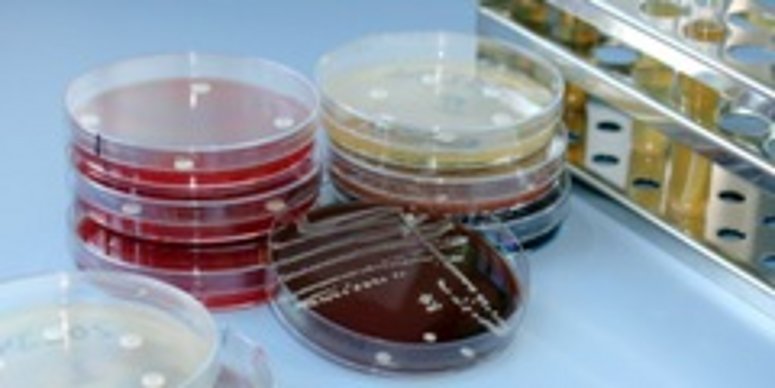Modern microbiological diagnostics combined with on-call service
The Division of Microbial Diagnostics has been accredited since 2005 and is subject to regular external quality assessments. Yearly, approximately 65.000 samples from patients of the Universitätsklinikum are analyzed. In case of a suspected infectious disease, our aim is to identify the causing agents (bacteria, fungus or parasites) and its antibiotic sensitivity as quickly as possible in order to adequately advise medical personnel at the bedside on the right therapeutic treatment. Our laboratory and the clinics work closely together: Important diagnostic findings are immediately communicated over the telephone and further diagnostic procedures and therapeutic measures are discussed. Furthermore, critical cases in intensive care units or wards for immunosuppressed patients are discussed on-site during weekly ward rounds. In case of infectiological emergencies, i.e. suspected bacterial infection of the eye or meninges, rapid diagnostics can improve the anti-infective treatment. For this purpose, we provide 24/7 microbiological on-call service.
The samples to be examined are delivered to the Microbiology Institute after being collected from the different clinics by the Klinik-Service-Gesellschaft. At the Microbiology lab, the samples are analyzed, depending on the request for examination, in the general bacteriological lab (“Varia”) or in the respective specialized lab (urine, stool, mycobacteria, fungus, leishmania, molecular biology, serology or hygiene lab).
Even in the age of molecular procedures, microscopy and the cultivation of bacteria and fungi on culture medium is still of high diagnostic relevance: By staining specially prepared specimens, one can quickly receive first evidence of an infection whereas by cultivation, one can separate the infectious agent from the human microbiome, determine the bacteria and moreover test the sensitivity and resistance to anti-infective drugs. However, results depend on proper handling and isolation of patient material, i.e. under sterile conditions and without fixation (untreated samples).
For some infections (lyme disease, sexually-transmitted diseases like syphilis, respiratory infections with coxiella, chlamydia or mycoplasma), the cultivation of the pathogenic agent is very tedious or simply not possible. In these cases, an infection can be indirectly determined by serological methods, i.e. by detection of specific antibodies in the patient’s serum. In some cases, for example, if an infection with the fungus aspergillus is suspected, a highly-sensitive detection of pathogen particles (antigens) is the method of choice. The third diagnostic method is the detection of pathogenic agents through molecular biological techniques which today are absolutely indispensable in the field of microbiological diagnostics. These techniques are particularly based on the amplification of nucleic acids (polymerase chain reaction, PCR). The PCR methods applied in the Microbiology Institute are used for (a) detecting a certain pathogenic agent, which in the case of a suspected resistant Staphylococcus aureus strain (MRSA) can be performed with a speed test; (b) detecting pathogenic bacterial molecules (so called virulence factors like Panton-Valentine Leukozidin PVL); or (c) to determine the mere presence of infectious bacteria. The latter can even be determined after the pathogenic agent has been decimated by antibiotic therapy and can therefore no longer be cultivated.
In the year 2009, two innovative methods were introduced in the institute. Firstly, the metabolism based methods to identify bacteria and certain fungi were largely replaced by a mass spectrometric analysis of pathogen proteins, which are tantamount to a fingerprint (so called MALDI-TOF technology). This new procedure has reduced the time period of diagnosis by at least 24 hours. Secondly, diagnostic requests as well as test results are now transmitted electronically. This was made possible by the establishment of a new laboratory information system.




